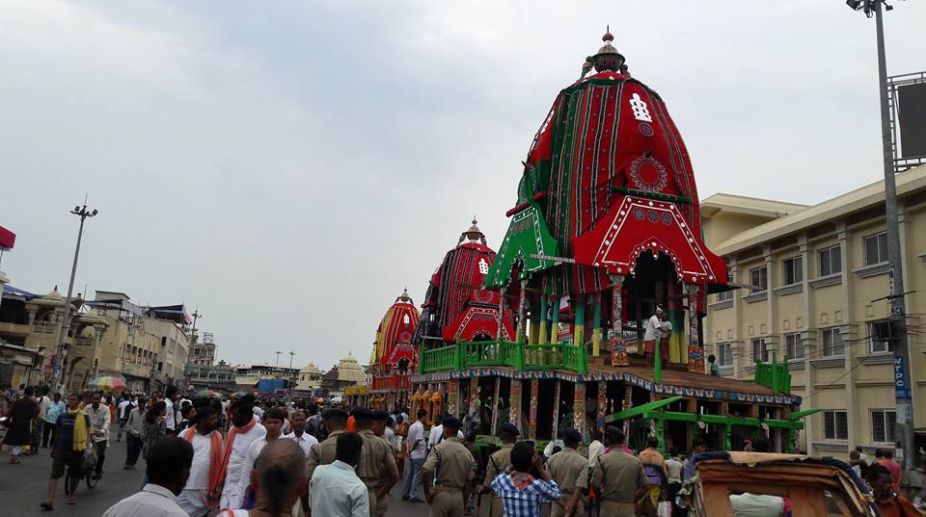Grand spiritual festival at Puri
10th of Baisakh, 1344 Bengali era, was the auspicious day when Thakur Sitaramdas Omkarnathdev received the divine command from Lord Jagannathdev to go and preach the Holy Name.

(Photo: Facebook)
Just like every year, this year too, the holy city, Puri will witness the grand procession of Lord Jagannath through pouring crowds of devotees brimming with enthusiasm. During mid-summer Lord Jagannath along with his elder brother Balaram and sister Subhadra travel to their garden palace – Gundicha temple for vacation, riding in grand chariots. On their way back home they halt at their aunt’s house – Mausi Maa temple where they are offered with poda pitha- a special type of baked pan cake. This belief of the Hindus has given rise to one of the biggest festivals of India- ‘Ratha Yatra’.
According to many people, the custom of placing idols on chariots and pulling them is of Buddhist origin. Fa Hien, the Chinese historian, who visit- ed India in the fifth century AD, had written about the chariots of Lord Buddha being pulled along public roads.
The festival begins with ‘Rath Prathishtha’ or invoking ceremony in the early morning which is followed by the Rath tana or chariot pulling – the most exciting part of the festival when they start rolling.
Advertisement
Each of these carriages has different specifications. The ‘Rath’ of Lord Jagannath is named ‘Nandighosha’ having 18 wheels and is about 45.6 feet high. On the other hand, the ‘Rath’ of Lord Balarama, ‘Taladhwaja’ , is about 45 feet high with 16 wheels, while Devdalana, the ‘Rath’ of Subhadra stands on 14 wheels and is about 44.6 feet high.
Apart from the age-old traditions and rituals of this grand festival, there are also some interesting facts about the ‘Rath yatra’ of Puri and the Jagannath temple.
How many know about the origin of ‘juggernaut’? History says that when the British saw this festival for the first time in the 18th century, they were so amazed that they sent extravagant descriptions of chariots being pulled through the streets of Puri by millions of people. From such depictions they gave birth to the word ‘Jug- gernaut’ meaning ‘the ruling force’.
Many of us would have heard about the inexplicable rainfall on the day of the festival.
According to a certain record, there hasn’t been a single year that it didn’t rain. There have been times that it didn’t rain for days but on that particular day it pours heavily. The construction procedure of the humongous chariots is also unique. These 45 feet carriages are constructed by a team of approximately 1400 carpenters without using any measurement tape. All that is used is an ancient technique of measurement using hands and finger lengths. The most interesting thing is that, not a single metal nail is used to build these massive ‘Raths’. Instead the old school method of using wooden pegs and joints are taken into consideration.
To construct these gigantic chariots, considerable amount of wood is required and that is supplied by the nearby forests of Dashpalla and Ranpur. The temple kitchen where the lord’s Mahaprasad (the main food) is cooked is the largest community kitchen in the world. Food for up to one lakh people can be made at a time in this kitchen. The most amazing fact is that the amount of food cooked every day remains the same and it has never been wasted.
‘Garva Muda’ and ‘Ratna Muda’ are said to be the two most mysterious parts of the temple. ‘Garva Muda’, the part of the temple where the precious jewellery of the Lord is said to have been stored is protected by heavenly divine souls and venomous snakes. The ‘Ratna Muda’ is the top most portion of the temple which is said to possess some magnetic powers within to sustain the electromagnetic forces acting upon it due to its geostationary location.
As per mythological belief of some people, the temple of Lord Jagannath is said to have been guarded by Lord Hanuman, to protect Subhadra from the hands of Samudra(ocean). That is why it is said that due to the might of Lord Hanuman, the Puri Samudra has retreated from its earlier position.
Earlier it used to be so vast that its waves often reached the temple floors. Needless to say, ‘Rath Yatra’ is one of the most awaited festivals of the ever exuberant Indians. Every year it draws multitudes of people swarming together just to get a glimpse of the Lord, and become a part of his grand journey.
Coordinator, Class XI, Patha Bhavan High School
Advertisement